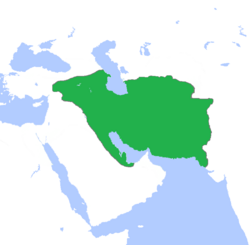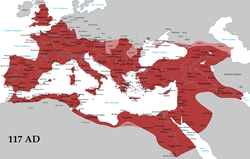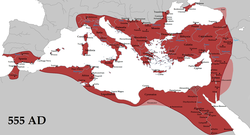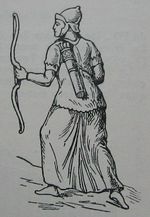Roman–Iranian relations
Relations between the Rome and Iranian states were established c. 96 BCE. It was in 69 BCE that the two states clashed for the first time; the political rivalry between the two empires would dominate all of Western Asia and Europe until 628. Initially commencing as arch-rivalry between the Parthians and Rome, from the 3rd to mid-7th centuries, the Byzantine Empire and its arch rival Sassanid Persia were recognized as the leading powers in the world.[1][2]




Relations during the Republic
The first direct contact between the Roman Republic and the Parthians was c. 96 BCE, when Lucius Cornelius Sulla, while proconsul in Cilicia, met the Parthian ambassador Orobazus. Plutarch reports that he managed to take the central seat between the Parthian Ambassador and an ambassador from Pontus, and concluded a treaty that set the Euphrates as the boundary between the two powers. Orobazus was executed on his return to Parthia for allowing Sulla to outmaneuver him, and Sulla himself later came under criticism for being too high-handed in his treatment of such a powerful nation.
The first time the Romans came into direct military contact with Parthia came when Lucullus invaded Armenia in 69 BCE, leading to diplomatic friction and clashes on the frontier between Armenia and Parthia. Over the following decades both empires became entangled in each other's civil wars, perhaps beginning with Crassus’s disastrous invasion of Parthia. Parthia was later involved in the civil war after the assassination of Julius Caesar. In 42 BCE, when Antony placed a legion in Syria, Cassius’ envoy Labienus joined forces with king Orodes of Parthia and, led by the Roman general Pacorus, attacked Antony’s republican forces. However, this was not to last as Antony successfully sent his general Publius Ventidius Bassus to recover the lost territory. After some difficulty dealing with local Parthian appointee kings, the Romans finally subdued the regained province and installed Herod the Great as king. Antony’s forces attempted a crossing of the Euphrates at the city of Zeugma but were held back by Parthian defences and had to settle for annexing the Armenian kingdom after deposing its king.
Relations during the Julio-Claudian dynasty

Augustus was loath to seek further conflict with Parthia. However, the coveted standards were still held by the Parthians and this was of great concern to Augustus, forcing him to regain them through a less conventional method. In 30 BCE, Phraates IV usurped the throne of Tiridates who fled to Syria under the protection of the Romans, whence he launched an attack on his native land. Although this failed, an agreement was made whereby he could live under the Romans as a king in exile if he brokered the return of the Roman standards. The standards were returned to the future emperor Tiberius, who received them on an island in the Euphrates.
The next half century saw relations between the two nations antagonistic but not overtly hostile, with the Romans unsuccessfully supporting a series of pretender kings, including Claudius in 49 CE, indicating the extent to which Rome was attempting to influence Parthian politics for its own ends. However, during the reign of Nero, Vologases I invaded Armenia and installed his own brother on the throne, disrupting the balance of influence which had hitherto existed there. The ensuing war was ended by a compromise which allowed the Parthian prince Tiridates and his descendants to reign in Armenia on condition that he and his successors received their crown from the Roman emperor and ruled as his clients.
Strabo described the Parthian Empire as the only rival existing to Rome.[3]
Relations during the Flavian dynasty
During Vespasian’s rule Parthia seemed to make some attempts to strengthening the ties between the two powers, such as asking to form an alliance at the Caucasus against belligerent Sarmatian tribes and offering assistance to Vespasian against the short lived emperor Vitellius once it became clear that Vespasian would rule. However, both of these Vespasian refused.
Relations in Late Antiquity


In the 2nd century CE, the balance of power shifted emphatically in favour of the Romans. A series of invasions repeatedly overran Mesopotamia and sacked the Parthian capital of Ctesiphon, made substantial territorial gains in northern Mesopotamia and benefited from the manipulation of frequent Parthian dynastic civil wars, which eventually undermined the Parthian state. Under Caracalla, an interesting twist in Parthian relations occurred. After submitting a request to marry the daughter of Persian king Artabanus V (potentially allowing an heir to assume control of both empires) Caracalla massacred the diplomatic party sent to arrange the marriage and attempted an invasion of Persia in 216. This was eventually unsuccessful and the Persians soon retaliated, inflicting heavy losses upon the Romans.
The replacement of the Parthian Empire by that of the Sassanids in 226 CE, which was more stable and effectively organised, shifted the balance of power against the Romans. The neighboring rivaling Sasanian Empire and the Roman-Byzantine Empire were recognized as the two leading world powers, for a period of more than 400 years.[4][5][6] Frequent Persian aggression during the 3rd century placed Roman defences under severe strain, but the Romans were eventually successful in warding these off and avoiding any territorial losses. Indeed, they eventually made significant gains towards the end of the century, although these were reversed in the mid-4th century. By that time, as Rome had become monotheistic like the Persians with their Zoroastrianism, conflicts attained an added religious dimension. It is in this context that the future of Roman–Persian relations would be played out over the remaining centuries, continuing into the Byzantine era. Neither side was able to inflict a decisive and convincing military victory against the other, and the movement between hostilities and diplomacy would continue to play out between each power.
See also
- Parthia
- Romans in Persia
- Roman Empire
- Byzantine Empire
- Roman-Persian Wars
- Sassanid dynasty
- Acacius of Amida
- Roman-Parthian Wars
- Mithraic mysteries
Notes
- ^ Norman A. Stillman The Jews of Arab Lands pp 22 Jewish Publication Society, 1979 ISBN 0827611552
- ^ International Congress of Byzantine Studies Proceedings of the 21st International Congress of Byzantine Studies, London, 21–26 August 2006, Volumes 1-3 pp 29. Ashgate Pub Co, 30 sep. 2006 ISBN 075465740X
- ^ Anthony Pagden. Worlds at War: The 2,500-Year Struggle Between East and West Random House Publishing Group, 25 mrt. 2008 ISBN 1588366782 p 84
- ^ (Shapur Shahbazi 2005)
- ^ Norman A. Stillman The Jews of Arab Lands pp 22 Jewish Publication Society, 1979 ISBN 0827611552
- ^ International Congress of Byzantine Studies Proceedings of the 21st International Congress of Byzantine Studies, London, 21–26 August 2006, Volumes 1-3 pp 29. Ashgate Pub Co, 30 sep. 2006 ISBN 075465740X
References
- K. Butcher, Roman Syria and the Near East, Getty Publications, Los Angeles, 2003 ISBN 0-89236-715-6
- R. C. Brockley, East Roman Foreign Policy, Francis Cairns Publications, Leeds, 1992 ISBN 0-905205-83-9
